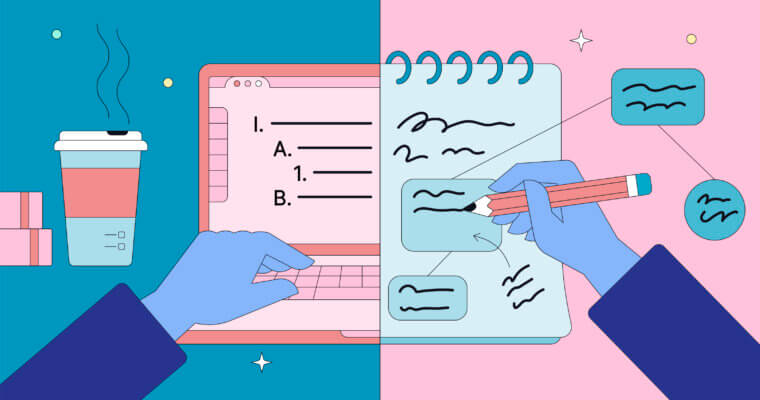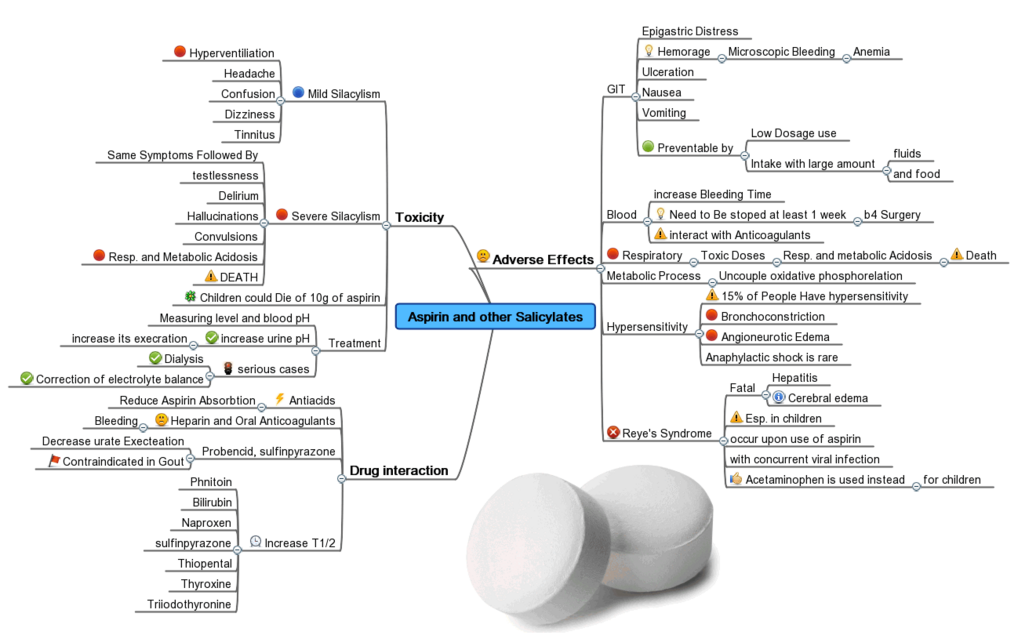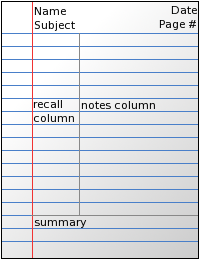
People with photographic memories can remember every word from a lecture or book, but the rest of us can benefit from taking notes! Note-taking is a natural and quite effective method of learning where you write down only the most important parts of a lesson or reading to review later. But the value you receive from note-taking is only as good as the notes themselves.
Whether you’re in high school, college, or grad school, we thought we’d share some tips on how to improve your own note-taking skills. Look below for better and more efficient ways you can take notes this semester.
Why take notes?
It’s almost impossible to remember everything you read or hear from your lessons—in fact, we forget 33% of what we don’t review within twenty-four hours. That’s why students almost always take notes; by writing down the essentials of a lesson during class or of a reading assignment, you can review the notes later to study, piece together the complicated parts you didn’t understand the first time, and reinforce your learning.
The more complex a lesson or topic, the more useful your notes are. For higher learning, like graduate school or when writing a thesis paper, you won’t get far without note-taking. Moreover, the act of writing information down helps you remember and recall it later. The combination of motor skills, touch sensation, visual cues, and extra time all facilitate memory formation more than just by listening or reading alone.
Once you have the notes, it’s up to you how you use them. We recommend reviewing them periodically until you internalize the information, but if you have a busy schedule, you can save them until it’s time to study for a test or write a research paper.
Handwritten vs. digital note-taking
Since computers became both common and portable, there’s a big debate about note-taking by hand vs. digitally on a laptop, tablet, or phone. Although research suggests taking notes by hand improves memory more than with a digital device, they each have their unique strengths that perform better in certain situations.
Pros of note-taking by hand:
- memory formation
- sketching or creating diagrams as visual aids
Pros of note-taking via digital device:
- speed
- physical convenience (fewer hand cramps)
- copying and sharing notes with others
Different methods of note-taking
Your notes are for your own personal use, so there’s no need to be formal about them—you won’t have to submit them as academic writing. On the other hand, the more organized and consistent they are, the more convenient they become.
With that in mind, there are a few different methods of note-taking for certain types of people or situations. We list five of the most common ones below so you can see if any options appeal to you.
Outlining
Outlining in note-taking—not to be confused with outlining as part of the writing process—is one of the simplest and most common ways to take notes. Points and keywords are written down in a hierarchical structure, typically in the same chronological order as they were discussed in the lesson.
Note-taking outlines are divided by main topics, subtopics, individual points, and subpoints, with room for examples and quotes as needed. This method works especially well with digital word processors, since you can also go back and add new points later.
Typically, outlined notes follow a structure of Roman numerals, capital letters, Arabic numerals, and lowercase letters (in that order), as in this example:
I. Main topic 1
A. Subtopic 1
1. Point 1
a. Subpoint 1 or example
b. Subpoint 2 or example
2. Point 2
B. Subtopic 2
II. Main topic 2
A. etc.
Charting
Charting is a particular type of note-taking that works best when multiple topics are discussed simultaneously, as with comparisons, or when one topic is dissected into multiple parts (i.e., pros/cons).
Essentially, you just divide your page into two or more columns, with each column assigned to a single topic. Every time a pertinent fact is mentioned for one of the topics, jot down a note in the corresponding column.
Charting helps keep your notes organized during lessons that go back and forth between topics rapidly. However, in lessons where only one topic is discussed at a time, this method will only slow you down.
Mapping
For visual thinkers, it might help to take notes using a mind map, or simply “mapping.” This note-taking technique utilizes branching graphs—like spider diagrams—to organize information in a way that’s easy to group and comprehend.
Mapping has its problems, especially when you have to guess how much space on your paper the information will take up. It’s best used when you’re having trouble organizing your own thoughts; seeing ideas linked visually can help you understand their connections.
For this reason, you might want to take notes in a more conventional way during the lesson, and then create a mind map afterwards from your notes to assist in studying.

An example of a mind map (source)
Cornell Notes system
Popularized by Cornell University professor Walter Pauk, the Cornell Notes system, also called the Cornell method, aims to make note-taking faster and more efficient by allocating dedicated space on a page for different types of information.
Basically, you divide your page into two columns: the recall column (left) accounts for one-third of your page, and the note column (right) accounts for two-thirds of the same page. In the recall column, you write the main topics, keywords, or questions, with supporting notes written directly across in the notes column.
At the bottom of the page, five to seven lines are reserved for a summary, where after the lesson or reading you reiterate the main points of the entire class, chapter, etc.

Cornell Notes in action (source)
SQ4R
The SQ4R method of note-taking is exclusively for note-taking while reading, so it won’t be of much use in a classroom. The name stands for the steps of the process:
- Survey: Take about three to five minutes to skim or “survey” the reading, writing down all the major headings, subheadings, topics, and other key points.
- Questions: Based on what you saw while surveying, write down any broad questions you have about the text.
- Read: Now, actually read the text, section by section, keeping an eye out for the answers to your questions from the previous step.
- Recite: After each section, write down all major ideas, keywords, and concepts—in other words, take notes. Again, answer the questions you posed in the second step as best you can.
- Relate: As a trick to enhance memorization, try to develop personal connections to what you just read. Can you relate to any of the topics discussed? Does the information remind you of anything in your own life?
- Review: When you’re finished, reread your notes to increase retention and help with studying.
This method was originally called SQ3R. The newest R, relate, was added subsequently after research showed a connection between personalizing information and retaining it.
7 advanced tips for note-taking
1 Add dates and topics at the top
Remembering which topics were discussed during which classes or chapters can get confusing, especially when you’re taking multiple courses at once. To stay organized, write the date and topic at the top of each new note-taking session. That’ll make it easier to find what you’re looking for later.
2 Prioritize the speaker or text
We all want our notes to be as thorough as possible, but don’t ignore the teacher or text because you’re too focused on note-taking. Always keep the speaker or reading at the center of your attention, and take notes only to complement your direct learning, not supplant it. Prioritizing notes over the lesson is putting the cart before the horse.
3 Prepare beforehand
There’s a lot going through your mind in the middle of class or during a reading session. Minimize the amount of distractions in your head by handling some of the busy work beforehand. This includes any reading or preparatory assignments that let you know what to expect during a lecture, as well as reviewing your previous notes so you don’t accidentally write the same thing twice.
4 Review notes while they’re fresh
A lot of people save their notes until study time, but it helps to review them once or twice shortly after they’re written. For one thing, this greatly improves memory retention and imprinting the information. Other benefits are to see if you missed anything, or to clarify a typo or word written sloppily. If you catch these mistakes too late, you may not remember what you were trying to say.
5 Pay attention for signals in lecture/reading
Certain words or phrases mentioned by a lecturer or book can signal the information will be important, as well as certain parts of the lesson like the beginning and end. If you can recognize these cues, you can be ready to take notes on what follows. Here are some examples of signals:
- opening
- closing
- introducing lists (“There are three reasons this occurs…”)
- repetition of the same phrase
- “for example . . .”
- “as a result . . .”
6 Identify what is and is not worth writing down
The advantage of note-taking is that it summarizes what you learned for quick reference. If your notes are just as long and detailed as the source material, they’re not exactly helpful.
Write down only what is essential, and leave out the rest. If you waste time writing down every tidbit or fact, not only will that distract from the actual lesson but also you won’t be able to differentiate what’s significant and what’s extra later. Personal anecdotes and off-topic tangents are good examples of when you don’t need to take notes.
7 Use shorthand if needed
Shorthand is just a fancy word for using abbreviations and other time-saving writing tricks. We use them all the time online and when texting so we can write more quickly, and that also applies to note-taking.
In particular, you can use “&” for and, “bc” for because and “ex.” for example, just to name a few. Feel free to invent your own shorthand for words that you personally use a lot—just don’t forget what they stand for!





